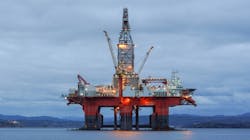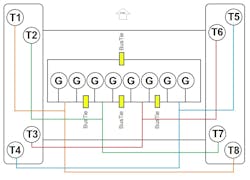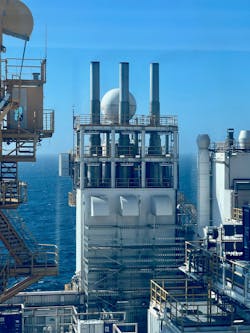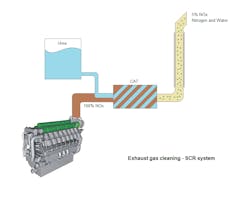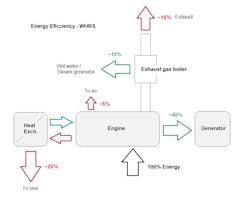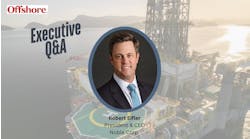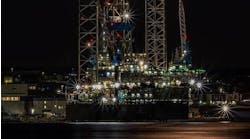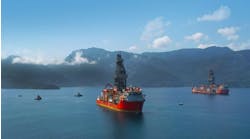Drilling rig contractors deploying latest emissions reductions technologies
Editor's note: This story first appeared in the November-December 2022 issue of Offshore magazine. Click here to view the full issue.
By Jaro Aarseth, Esgian
In this new era of ESG goals and priorities, offshore drilling rig contractors are pursuing development of multiple technologies that will enable them to lower their emissions and reduce their carbon footprint.
But, as ever, the fundamental question remains – how can emissions be managed so they are minimized as much as possible? And, critically – at what cost and return of investment? These questions must be at the forefront of strategy for every drilling contractor and operator as climate concerns are here to stay.
Additionally, with the mounting demand for energy supply, offshore operators that have the ability to increase their production are now being urged ramp up their efforts. And thus, the pressure is on to increase capacity while remaining focused on lower emissions.
So, how will the offshore industry – and drilling rig contractors and operators in particular – navigate the future in this environment? This is where the industry’s approach to sustainable solutions comes to the fore. Let’s look at the progress that drillers have made towards sustainability in these past few years. To prepare for what is coming, some companies have been able to upgrade their drilling rigs to a greener profile. They have done this through complex integration efforts and complicated modification programs that have required innovative products and technologies, and expensive investments. However, the cost of those investments has often been steep and thus difficult to undertake at a time of low day rates and marginal profits, which have characterized the market in recent years.
Luckily there is good news. Today there are a growing number of well-tested emission reduction systems and energy efficiency systems available, and these are being implemented even as we speak. Often, these systems are being developed as a joint effort between offshore operators and drilling contractors. In some cases, there is even government interest and participation as well.
Today, Esgian works with offshore operators, vendors and suppliers, governments and stakeholders all over the world to track the latest emissions reductions technologies, and their deployment in the field to date. By mapping out the specifications of the entire global fleet of offshore units, we are now able to describe and summarize the most well-tested and effective emissions-reduction systems installed on today’s offshore rigs.
To fully appreciate how the different systems are utilized and why they prove effective on the rigs and vessels on which they are installed, it is important to be aware of a few criteria. With different emissions reduction systems installed, it is possible to achieve – depending on rig operator interest and priorities – either improved operational efficiency or reduction of waste energy; or reduced and cleaner emissions; or of course, some combination of all of these goals for those who are completely vested.
Let us have a look at the available product categories, in no particular order, and the drilling units to which they are best suited.
Energy storage systems
ESS technologies are being installed on a growing number of semisubmersibles and jackup rigs. These systems are proven to be effective on different levels and with a variety of capacities, such as:
- Peak shaving
- Alternative redundancy
- Spinning reserve and power recycling.
The ESS usually includes: a set of batteries for different purposes and defined capacities; clean grid converters; transformers; and feeders. When used as spinning reserve, the battery packs have to be quite large to be able to deal with loss of power and maintaining redundancy, while peak shaving usually requires less battery capacity. With both approaches, the amount of running time imposed on engines decreases; and as such, it has a decent return on investment due to reduced fuel and maintenance cost. The batteries are connected to the distribution system via the grid convertors, and the system delivers power when needed and is recharged when necessary. The system is well suited for all offshore units, including jackups, semisubs and drillships, and although it is quite costly at the point of investment, mainly due to the large battery packs, it has the potential to harvest good returns over time.
Closed ring system
The most widely used emission reduction system on offshore units today, a closed ring system enables a drilling rig to be run with joint main switchboards; reduces running time on engines; and avoids poor load factors due to redundancy. The closed ring system is suitable for all types of offshore units with multiple engine rooms, but is particularly smart for dynamically positioned vessels requiring redundancy.
The closed ring system comes in two main variants: “open all” or “isolate.” The main difference is the action taken when a short circuit occurs on the main distribution boards. The open all solution will open all bus tie breakers in the system while the isolated system will contain the problematic switchboard. The benefit of the latter is that you will only lose one switchboard and can reduce another engine, while the open all requires one engine on each board. If a short circuit occurs, the bus tie breakers will be ultra-fast and open before the neighboring switchboards are affected. This way, the amount of running engines can be reduced in certain scenarios.
Using the full potential of a closed ring system can:
- Reduce the number of running engines
- Increase the load on each running engine to have it operate under more ideal load conditions
- Reduce the number of auxiliaries.
Transocean has installed a closed ring system on a major part of its fleet.
Selective catalytic reduction
Another system widely installed among offshore drilling units is the SCR system, which reduces NOx emissions by a whopping 95% on average. This is an especially profitable upgrade on the Norwegian Continental Shelf as the upgrade is heavily funded by the NOx fund in Norway.
While the other systems mentioned so far actually help reduce the energy consumption and help the unit operate with a higher energy efficiency, the SCR system cleans all NOx emissions emitted regardless of amount and why it is emitted. However, it does not do anything to reduce CO2.
For comparison, if you are in possession of a diesel car built in recent decades, it most likely has something called an EGR valve, which returns parts of exhaust gases back to the combustion process. This is to lower the temperature of the combustion process and thereby reduce NOx to required standards. An SCR solution, on the other hand, allows the engine to operate under optimal combustion temperatures, but that in turn produces an unacceptable amount of NOx. However, the main treatment process of the exhaust gases is done through a chemical reaction. The exhaust gases are passed through a system called a decomposition reactor, which reacts the nitrogen oxide (from the exhaust) with diesel exhaust fluid (DEF), which is most commonly a combination of de-ionized water and urea. This reaction effectively produces water and nitrogen, which are environmentally safe.
With a fully operational SCR system, you achieve approximately 95% reduction in NOx emissions. The SCR system is installed across a wide range of drillships, semisubs and jackups, with the Maersk Integrator being one of them.
Waste heat recovery system
Heat is one of the bigger known waste energies. WHRS installations are on the rise, and although they may be more utilized on ships than rigs, it is a system worth looking into. Depending on how many engines and boilers are running at once, the potential to save energy is certainly present, as waste heat of different quantities is produced at all times.
The WHRS comes in a variety of solutions, the most common and simple of which is an exhaust gas boiler. By installing exhaust gas boilers, the waste heat emitted through the exhaust from the main engines can be used to heat water and supply the hot water requirement onboard, reducing the electricity needed to heat water, and thus the use of diesel-fired boilers. More advanced systems are also available, where electric energy can be produced by use of steam generators. Analysis is done to examine which system is most suitable to which vessel.
Digitalization software
There is also an increased focus on digitalization of operations, with the goal of reducing downtime and energy wastage. There are quite a few types of efficiency software available on the market. And although they often require less investment and as much downtime to retrofit as the more costly, heavy duty, physical emission reduction systems, they might be quite capable when used to their full potential. Either way, to be able to analyze where energy and time is wasted in the operation, and where the greatest potential can be found to reduce emissions – there is hardly a better place to start.
This type of software has the potential to:
- Improve drilling operation efficiency
- Record real time data and consumption on board
- Increase the operational window, reducing conservatism
- Reduce standby time of load-demanding equipment on board
- Reduce engine standby time.
The different systems have a wide variety of functions and areas of use, including: making drilling operations more efficient; reducing non-productive time; and using calculations and forecasting to increase the operating window, thereby reducing conservatism. They often come as standalone, manual offline systems, but can also be more sophisticated online systems integrated with sensors and automation on board.
Alternative fuels
While a range of emission reductions technologies are being developed and deployed, a new area of emissions reduction has emerged: alternate fuels. While some fuel additives are already being tested on some drilling units, engine manufacturers are working around the clock to explore opportunities to shift combustion engines to run on ammonia, hydrogen, and methanol, just to name a few alternate fuels.
Need for buy-in
At the end of the day, the development and adaption of all these emission-reduction systems relies a great deal upon the market situation, in addition to rules and regulations from authorities. But it also comes down to the willingness and support to the emission reduction mission by responsible offshore companies, and the people that work for them.
